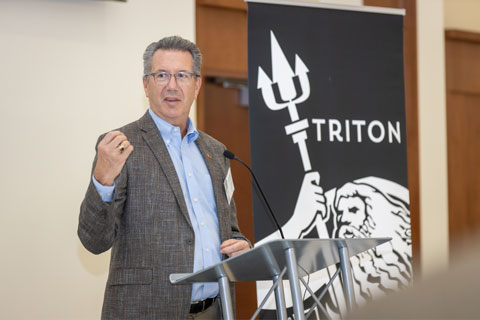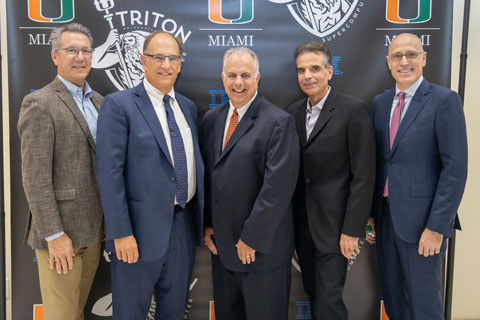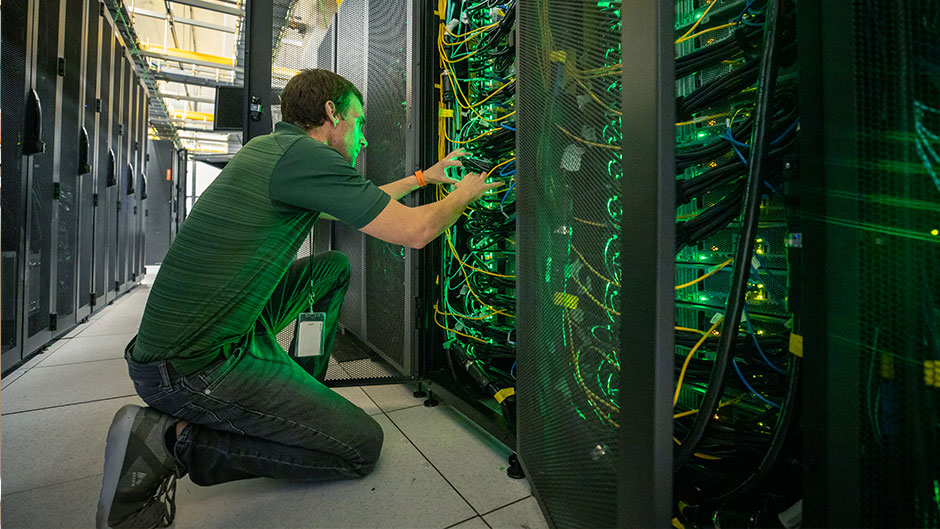Students and faculty at a University of Miami depend on technology constantly. And for those who deal with large data sets to conduct their research, waiting on computers to process the information is tedious.
That’s why the University’s Center for Computational Science (CCS) recently designed and purchased a new supercomputer named Triton that can accelerate data analysis and expand the possibilities for digital research. Recently, CCS celebrated the launch of Triton, a $3.7 million machine that is now accessible for students, faculty, and staff. Trainings will be held at UM’s Coral Gables, Rosenstiel and Medical campuses in the next few months to familiarize the community with the new technology.

“At UM, our mission statement is we transform lives and we do that because we attack and we pursue these important problems,” said Jeffrey Duerk, executive vice president for academic affairs and provost. “It’s essentially our ability to attack problems that we couldn’t do without these types of assets like the supercomputer, so when it came to me that the idea of upgrading our facilities after a number of years, this was an easy investment.”
Custom-made for the University by IBM, the new system was assembled and programmed in California, but is now housed at the Network Access Point (NAP) facility in downtown Miami. One of the main benefits of Triton is it will allow researchers to easily and quickly employ computing strategies like machine learning and artificial intelligence, which took longer to process on UM’s previous systems, said Nicholas Tsinoremas, CCS director, and Joel Zysman, director of advanced computing.
“We want to create the next generation of infrastructure at UM so that faculty, staff, and students are prepared for the onslaught of data collection that’s available — not only for scientific discovery but for all subject areas,” Tsinoremas said.
The new system, called an IBM Power System, is a sibling of one of the most powerful supercomputers in the country, located at the U.S. Department of Energy’s Oak Ridge National Laboratory, Tsinoremas said. IBM staff on hand at the launch said Triton will rank among the top five university supercomputers of the 500 supercomputers in total scattered throughout the world. UM’s first supercomputer—Pegasus I—was unveiled in 2008. In 2013, it was updated to add more processing and storage capacity and renamed Pegasus II.
“The past were all significant steps [for UM], but this is an exponential next phase in technological capacity,” Tsinoremas said. “It’s a revolution from traditional supercomputer technology.”
Although older supercomputers were simply fast at crunching numbers (their productivity was measured in calculations per second), this supercomputer will process data more efficiently, so that now CCS staff will be able to talk about how many terabytes they can process and analyze per second. For example, instead of researchers having to upload files in batches, they will now be able to log in to a session and interact with the data while it is being processed.

“Everything from retrieving data, to processing data, to analyzing it and presenting results is now viewed as a whole,” Zysman said.
The new system will also enable more computer vision projects, which analyze images to draw conclusions, such as facial recognition technology. These images are then used for machine learning and deep learning projects, where computer algorithms are trained to make decisions like a human would, but require large data sets to “learn” from.
Another upgrade includes the fact that students and faculty will be able to access the supercomputer from their laptops, login and start processing data independently. Currently, only about 1,500 people on UM’s three campuses utilize the supercomputer, primarily in the sciences, but with the new equipment in place and the advent of data science research among professors in the humanities, political science, law, and music, CCS expects more traffic.
“We expect that more people will take advantage of these resources and we want to make it as easy as possible to do it,” Zysman said.

